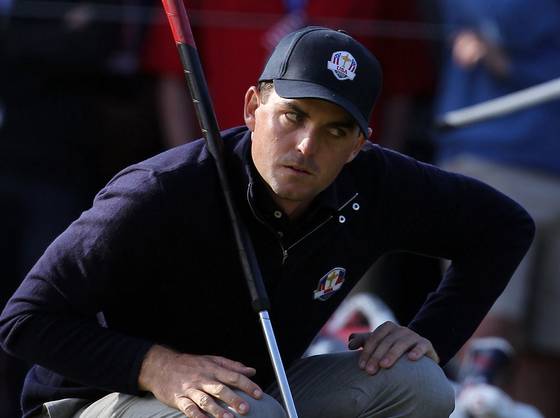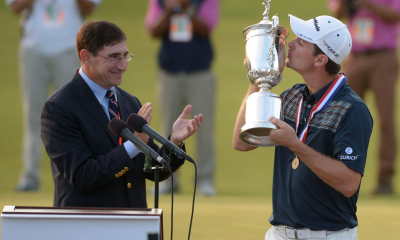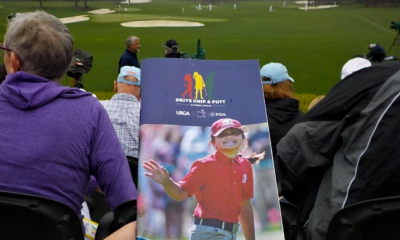Opinion & Analysis
Op-ed: Banning the anchored stroke is bad for golf

By Ryan David
GolfWRX Contributor
There has been speculation for over a year now, and we finally have some sort of confirmation. The USGA and the R&A have hinted they will ban the anchored stroke sometime “in the coming months.” USGA Executive Director Mike Davis presented the topic recently to the PGA Tour Policy board, to mixed reviews. While I’m sure the USGA understands it will have a fight on its hands from professionals, I’m not convinced they understand how a belly ban will hurt the game overall.Keegan Bradley spoke out recently, telling Golfweek,
“I’m going to do whatever I have to do to protect myself and the other players on Tour.”
Ernie Els, who won The Open Championship in 2012 with an anchored stroke (remember, Adam Scott lost the Open with a long putter) has famously been quoted as saying,
“As long as they’re legal, I’ll keep cheating like the rest of them.”
Okay, fine. To me, Bradley doesn’t issue the statement as a protection of an advantage. He understands that as a professional an equipment change of that magnitude requires a major adjustment and really doesn’t equal the playing field. It’s obvious that in the world of golf, anchoring the putter is a divided and heated issue. It’s also an irresponsible and short-sighted move by the USGA and R&A to ban it.
In a nutshell, the mission of the USGA serves to preserve and foster growth of the game to all who love and respect it. No mention here of preserving integrity of Tour players or tour equipment. A ban on an anchored stroke would leave the casual/beginning golfer in the cold. In order for the game to grow, it must appeal to a wider audience. An anchored stroke helps derive enjoyment out of the game far sooner for a new golfer, increasing the likelihood of retention. We’re a passionate and driven community here at GolfWRX, so thinking about golfers at the margins can sometimes be difficult.
The USGA ‘Tee-it-Forward’ initiative was a step in the right direction to growing the game. By helping players understand the relative distances and advantages of playing a slightly shorter course, the USGA opened the game to a broader audience. To me, it just seems a little odd that one hand promotes a faster, simpler game while the other takes strides to make it more difficult for some. If I were a cynic, I’d imagine Mr. Davis sitting back and saying, “Play up guys, because your wedges are duller, your putter is shorter and you need all the help you can get.”
Understandably, It is a delicate balancing act to build an inclusive environment for new golfers and reign in Tour players from shooting the lights out. They’ve spent too much effort and time during these last few years focusing on pros and not building relationships with beginners and casual players.
The governing bodies need to take a step back and generate a holistic view of putter performance and regulate from there. In my hasty analysis, I could not find any rules regarding weight or MOI rating. Since most of the belly putters of note are mallet style, is it possible that the anchored stroke alone is not the entire driver of the advatange of a belly putter? Although a ban on anchoring seems a foregone conclusion at this point, I’d hope the USGA/R&A would take a deep breath, ignore the media frenzy and make the right decision for the future of the game we all love.
Opinion & Analysis
The 2 primary challenges golf equipment companies face

As the editor-in-chief of this website and an observer of the GolfWRX forums and other online golf equipment discourse for over a decade, I’m pretty well attuned to the grunts and grumbles of a significant portion of the golf equipment purchasing spectrum. And before you accuse me of lording above all in some digital ivory tower, I’d like to offer that I worked at golf courses (public and private) for years prior to picking up my pen, so I’m well-versed in the non-degenerate golf equipment consumers out there. I touched (green)grass (retail)!
Complaints about the ills of and related to the OEMs usually follow some version of: Product cycles are too short for real innovation, tour equipment isn’t the same as retail (which is largely not true, by the way), too much is invested in marketing and not enough in R&D, top staffer X hasn’t even put the new driver in play, so it’s obviously not superior to the previous generation, prices are too high, and on and on.
Without digging into the merits of any of these claims, which I believe are mostly red herrings, I’d like to bring into view of our rangefinder what I believe to be the two primary difficulties golf equipment companies face.
One: As Terry Koehler, back when he was the CEO of Ben Hogan, told me at the time of the Ft Worth irons launch, if you can’t regularly hit the golf ball in a coin-sized area in the middle of the face, there’s not a ton that iron technology can do for you. Now, this is less true now with respect to irons than when he said it, and is less and less true by degrees as the clubs get larger (utilities, fairways, hybrids, drivers), but there remains a great deal of golf equipment truth in that statement. Think about it — which is to say, in TL;DR fashion, get lessons from a qualified instructor who will teach you about the fundamentals of repeatable impact and how the golf swing works, not just offer band-aid fixes. If you can’t repeatably deliver the golf club to the golf ball in something resembling the manner it was designed for, how can you expect to be getting the most out of the club — put another way, the maximum value from your investment?
Similarly, game improvement equipment can only improve your game if you game it. In other words, get fit for the clubs you ought to be playing rather than filling the bag with the ones you wish you could hit or used to be able to hit. Of course, don’t do this if you don’t care about performance and just want to hit a forged blade while playing off an 18 handicap. That’s absolutely fine. There were plenty of members in clubs back in the day playing Hogan Apex or Mizuno MP-32 irons who had no business doing so from a ballstriking standpoint, but they enjoyed their look, feel, and complementary qualities to their Gatsby hats and cashmere sweaters. Do what brings you a measure of joy in this maddening game.
Now, the second issue. This is not a plea for non-conforming equipment; rather, it is a statement of fact. USGA/R&A limits on every facet of golf equipment are detrimental to golf equipment manufacturers. Sure, you know this, but do you think about it as it applies to almost every element of equipment? A 500cc driver would be inherently more forgiving than a 460cc, as one with a COR measurement in excess of 0.83. 50-inch shafts. Box grooves. And on and on.
Would fewer regulations be objectively bad for the game? Would this erode its soul? Fortunately, that’s beside the point of this exercise, which is merely to point out the facts. The fact, in this case, is that equipment restrictions and regulations are the slaughterbench of an abundance of innovation in the golf equipment space. Is this for the best? Well, now I’ve asked the question twice and might as well give a partial response, I guess my answer to that would be, “It depends on what type of golf you’re playing and who you’re playing it with.”
For my part, I don’t mind embarrassing myself with vintage blades and persimmons chasing after the quasi-spiritual elevation of a well-struck shot, but that’s just me. Plenty of folks don’t give a damn if their grooves are conforming. Plenty of folks think the folks in Liberty Corner ought to add a prison to the museum for such offences. And those are just a few of the considerations for the amateur game — which doesn’t get inside the gallery ropes of the pro game…
Different strokes in the game of golf, in my humble opinion.
Anyway, I believe equipment company engineers are genuinely trying to build better equipment year over year. The marketing departments are trying to find ways to make this equipment appeal to the broadest segment of the golf market possible. All of this against (1) the backdrop of — at least for now — firm product cycles. And golfers who, with their ~15 average handicap (men), for the most part, are not striping the golf ball like Tiger in his prime and seem to have less and less time year over year to practice and improve. (2) Regulations that massively restrict what they’re able to do…
That’s the landscape as I see it and the real headwinds for golf equipment companies. No doubt, there’s more I haven’t considered, but I think the previous is a better — and better faith — point of departure when formulating any serious commentary on the golf equipment world than some of the more cynical and conspiratorial takes I hear.
Agree? Disagree? Think I’m worthy of an Adam Hadwin-esque security guard tackle? Let me know in the comments.
@golfoncbs The infamous Adam Hadwin tackle ? #golf #fyp #canada #pgatour #adamhadwin ? Ghibli-style nostalgic waltz – MaSssuguMusic
Podcasts
Fore Love of Golf: Introducing a new club concept

Episode #16 brings us Cliff McKinney. Cliff is the founder of Old Charlie Golf Club, a new club, and concept, to be built in the Florida panhandle. The model is quite interesting and aims to make great, private golf more affordable. We hope you enjoy the show!
Opinion & Analysis
On Scottie Scheffler wondering ‘What’s the point of winning?’

Last week, I came across a reel from BBC Sport on Instagram featuring Scottie Scheffler speaking to the media ahead of The Open at Royal Portrush. In it, he shared that he often wonders what the point is of wanting to win tournaments so badly — especially when he knows, deep down, that it doesn’t lead to a truly fulfilling life.
View this post on Instagram
“Is it great to be able to win tournaments and to accomplish the things I have in the game of golf? Yeah, it brings tears to my eyes just to think about it because I’ve literally worked my entire life to be good at this sport,” Scheffler said. “To have that kind of sense of accomplishment, I think, is a pretty cool feeling. To get to live out your dreams is very special, but at the end of the day, I’m not out here to inspire the next generation of golfers. I’m not out here to inspire someone to be the best player in the world, because what’s the point?”
Ironically — or perhaps perfectly — he went on to win the claret jug.
That question — what’s the point of winning? — cuts straight to the heart of the human journey.
As someone who’s spent over two decades in the trenches of professional golf, and in deep study of the mental, emotional, and spiritual dimensions of the game, I see Scottie’s inner conflict as a sign of soul evolution in motion.
I came to golf late. I wasn’t a junior standout or college All-American. At 27, I left a steady corporate job to see if I could be on the PGA Tour starting as a 14-handicap, average-length hitter. Over the years, my journey has been defined less by trophies and more by the relentless effort to navigate the deeply inequitable and gated system of professional golf — an effort that ultimately turned inward and helped me evolve as both a golfer and a person.
One perspective that helped me make sense of this inner dissonance around competition and our culture’s tendency to overvalue winning is the idea of soul evolution.
The University of Virginia’s Division of Perceptual Studies has done extensive research on reincarnation, and Netflix’s Surviving Death (Episode 6) explores the topic, too. Whether you take it literally or metaphorically, the idea that we’re on a long arc of growth — from beginner to sage elder — offers a profound perspective.
If you accept the premise literally, then terms like “young soul” and “old soul” start to hold meaning. However, even if we set the word “soul” aside, it’s easy to see that different levels of life experience produce different worldviews.
Newer souls — or people in earlier stages of their development — may be curious and kind but still lack discernment or depth. There is a naivety, and they don’t yet question as deeply, tending to see things in black and white, partly because certainty feels safer than confronting the unknown.
As we gain more experience, we begin to experiment. We test limits. We chase extreme external goals — sometimes at the expense of health, relationships, or inner peace — still operating from hunger, ambition, and the fragility of the ego.
It’s a necessary stage, but often a turbulent and unfulfilling one.
David Duval fell off the map after reaching World No. 1. Bubba Watson had his own “Is this it?” moment with his caddie, Ted Scott, after winning the Masters.
In Aaron Rodgers: Enigma, reflecting on his 2011 Super Bowl win, Rodgers said:
“Now I’ve accomplished the only thing that I really, really wanted to do in my life. Now what? I was like, ‘Did I aim at the wrong thing? Did I spend too much time thinking about stuff that ultimately doesn’t give you true happiness?’”
Jim Carrey once said, “I think everybody should get rich and famous and do everything they ever dreamed of so they can see that it’s not the answer.”
Eventually, though, something shifts.
We begin to see in shades of gray. Winning, dominating, accumulating—these pursuits lose their shine. The rewards feel more fleeting. Living in a constant state of fight-or-flight makes us feel alive, yes, but not happy and joyful.
Compassion begins to replace ambition. Love, presence, and gratitude become more fulfilling than status, profits, or trophies. We crave balance over burnout. Collaboration over competition. Meaning over metrics.
Interestingly, if we zoom out, we can apply this same model to nations and cultures. Countries, like people, have a collective “soul stage” made up of the individuals within them.
Take the United States, for example. I’d place it as a mid-level soul: highly competitive and deeply driven, but still learning emotional maturity. Still uncomfortable with nuance. Still believing that more is always better. Despite its global wins, the U.S. currently ranks just 23rd in happiness (as of 2025). You might liken it to a gifted teenager—bold, eager, and ambitious, but angsty and still figuring out how to live well and in balance. As much as a parent wants to protect their child, sometimes the child has to make their own mistakes to truly grow.
So when Scottie Scheffler wonders what the point of winning is, I don’t see someone losing strength.
I see someone evolving.
He’s beginning to look beyond the leaderboard. Beyond metrics of success that carry a lower vibration. And yet, in a poetic twist, Scheffler did go on to win The Open. But that only reinforces the point: even at the pinnacle, the question remains. And if more of us in the golf and sports world — and in U.S. culture at large — started asking similar questions, we might discover that the more meaningful trophy isn’t about accumulating or beating others at all costs.
It’s about awakening and evolving to something more than winning could ever promise.























Tim Schoch
Mar 6, 2013 at 12:53 pm
Bernhard Langer. He turned his putting around with the long stick. So have many others. Whether is it psychological or a cure for the yips or a very real advantage, I think it is individual to each player’s needs. A golf swing is a swing, not a shove. It is irrelevant if we’re waking up to this after so many years. Better late than never. Unless we want to see players strapping drivers to their forearms or employing elevator spikes that lift you up above hazards and hills. The PR damage is already done.
Jim M
Nov 8, 2012 at 11:19 am
There is zero statistical evidence to suggest that the long putters provide any advantage. When the USGA spoke to the policy board, they admitted that the proposed ban was more about perception than reality. The announcers keep insisting that it gives someone an advantage, so the public believes it gives someone an advantage. I fail to see how golf is a better place if we drive Langer, Couples, Els, Scott and Bradley from the game
ElVerde
Nov 6, 2012 at 10:08 am
Golf is inherently a game that allows tinkering with equipment…I think of NASCAR as pretty similar. We all have to work within the same framework, but there is room to play.
This is why golfers can use different shafts, different drivers, different putters, even different length clubs, etc. It’s like using a different gear ratio in a NASCAR…as long as it’s in the same transmission as everyone else!
The anchored stroke is a fundamentally different stroke, and that is why it should be banned. It would be like running a rear-engined NASCAR…not necessarily better or worse, but DIFFERENT.
Someone else up here mentioned straddling the putting line, and I think it’s a pretty apt comparison. Where do we draw the line?
adam
Nov 4, 2012 at 10:13 am
14 year-old Guan Tianglang of China just qualified for the 2013 Masters. He uses a belly putter. If you don’t ban them now, we’ll see more and more kids go in that direction. It’s now or never, babay.
Courtney Zimmerman
Nov 1, 2012 at 2:23 pm
On a website like this where people are gaining distance through perfecting launch etc through high end shafts and tinkering, if you are going to ban anchoring because of the advantage it provides, then all competition should go back to steel shafts and persimon heads and blades only. Lets take away distance gained by weaker smaller players and you will go back to guys like Tiger dominating through strength. Leaves most of the new competitors out of the winners circle. I dont use an anchored putter currently, I have used one and don’t make any more putts with or without but am a much better lag putter without. Doing what I mentioned is no different than what they are doing with guys like Keegan who have had the option their entire lives to play with the long putter and now that success comes to them they are calling it an unfair advantage. USGA and R&A are being too quick to judgment on this one. Senior competitors in USGA events who need it for their back and are successful are hosed. Does this mean they are a bad putter with a short putter, no, it simply allows them to practice and play more, isnt that the point?
JG
Nov 1, 2012 at 5:54 pm
no, all arguments wrong. Senior players with bad backs??? haha wow. The can have a putter as long as they want. It is anchoring that is the issue not length. Its against the rules already!! why it was ever approved for tournament play is beside me.
kevin smith
Nov 1, 2012 at 10:58 am
Keegan uses his shirt to anchor the butt end of his putter. Watch how he lifts his shirt and then positions the butt.
What is next , a shirt with a stomach holster built in soo he can anchor his putter and also carry the american flag at the olympics?????
kevin smith
Nov 1, 2012 at 10:20 am
Anchoring of the putter is the question , not the Belly or long putter….This anchoring of the putter is bad for the game of golf!!!
Zooch
Nov 1, 2012 at 9:51 am
People who dislike belly putters only dislike them for asthetic reasons. If you’re honest. It’s going to be an arguement that nobody will win until someone can produce some empirical evidence to show that these really are the bain of golf. and PS they’ve been around for a while.
Prut
Nov 1, 2012 at 9:50 am
If you had a $100, you wouldn’t be able to buy an anchored putter.
obvioustroll
Nov 1, 2012 at 8:56 am
i bet 100 dollars that if you had an absolutely flat surface and a 5 meter putt, anchored putters will have higher consistency of making it… they should ban it.
Tim
Nov 1, 2012 at 8:34 am
All I know is that at 64 yo I was ready to give the game up due to my putting. Since going to the belly I find myself enjoying the game again.
I am an not a professional and there will never be a time now that I will be one. However, I am sure that I represent a much higher number than the professional ranks when it comes to enjoyment of the game. Banning the body-anchored putter will set back our games to the point of reducing the number of players that the USGA wants to see playing each year. I am sure the equipment mfg feel the same.
Jeffrey
Nov 1, 2012 at 7:48 am
There is no advantage to a belly or anchored putter. It’s just a different method. I have extensively tested belly vs short putter using on course data and software stroke data and I was slightly better with a short putter. Anchoring a putter removes freedom and feel from a stroke. If an anchored putter was truly an advantage everyone on tour would use it because their putting stats would dramatically improve. Belly putter banners seem to look at it like the ones who use it get an advantage like using a titanium 460 cc driver vs a persimmon wood.
James
Nov 1, 2012 at 5:59 am
You can’t be serious that belly putters keep hundreds or thousands of people interested or willing to take up the game of golf, because its easier to score? Surely factors such as affordability and time (especially for people with young families) a far more influential factors.
Belly and broomstick putters and their allowed use have been a blight on the game for too long,. It’s not golf it’s croquet – and any argument that says differently comes from a place of self interest.
The problem is not a ban, it’s that they’ve been allowed in competition in the first instance.
As for allowing pros to have different rules to amateurs(?) That is a terrible and flawed argument. If anything pros should uphold the rules and if anything play to stricter standards and set an example to the rest of us – not be given a break because it is their chosen profession.
Good luck in court Keegan. I am sure your very expensive lawyer is talking up your chances.
Lenny
Nov 8, 2012 at 3:26 pm
+1
chris
Nov 1, 2012 at 1:54 am
Let’s not worry that Keegan hit driver 9 iron to a 497 yard hole…surely the belly putter is what is ruining the game!
This discussion is a laughable joke.
March
Nov 1, 2012 at 11:00 pm
Very true. Carbon fiber, graphite, titanium clubs, 3,4 and 5 compound laser straight balls. Putter heads of every shape and size. But the belly putter is the only thing that is in focus. Oh yea, changing the grooves was another huge jump in curbing the pros.
Christian
Oct 31, 2012 at 11:43 pm
Keegan Bradley is one of my favorite players, and I use to be against the belly putter completely and I thought it was a crutch as well. I still think the belly putter gives the player an advantage, however, banning it would be bad for the game if you ask me. Yes nerves is a part of the game, but is your driving and iron play nerve proof? Is bunker play and flop shots not affected under pressure? All of them are. A belly putter is a great training aid if you ask me. And I think it won’t affect putting statistics in the long run. I think if you take it away it does more harm than good. I use a conventional putter and I will continue to because it’s comfortable and it’s what I know. I think they should be legal, period.
joe
Oct 31, 2012 at 10:37 pm
The usga should have addressed the belly putter years ago. Doing so now just because young guys are winning with it seems like it was a response directly to those guys. I think Keegan has a point given the amount of work he has put in to master the belly putter. I never liked him before but his style of play and grit, and now standing up for what he thinks is right (even if I disagree with him) shows character.
Gm
Oct 31, 2012 at 9:03 pm
NOT banning the anchored putter is bad for golf, just as square grooves was bad for golf.
Randall
Oct 31, 2012 at 7:58 pm
They are not making the game harder for the hackers. Most weekend golfwrx don’t follow the rules, so it will not affect. The fact is the rule book has said no part of the club can be anchored to anything other than the hands. The pros have been cheating for years; hence Ernie’s statement. They need to be held to a higher standard. I love watching Keegan and Web play, but they are breaking the rules
Kkoz17
Oct 31, 2012 at 7:29 pm
I disagree. When a golfer is a notoriously bad putter and then switches to an anchored putter and becomes an above average putter, that is a clear problem. Ban them and don’t look back!!!!!
Gm
Oct 31, 2012 at 9:06 pm
Precisely! And by Keegan saying that he will take the Rules to court, he’s ADMITTING to the whole world that the anchored IS HELPING him make putts. Duh.
jay hall
Oct 31, 2012 at 7:18 pm
The fact is the USGA and R&A should NOT set the rules for the professionals. The pros should have different rules from the amateurs, the game they play is night and day from 99.9% of amateurs out there so why make rules that make it harder for the guys who sux!!!
Gm
Oct 31, 2012 at 9:05 pm
@jay hall
That still doesn’t help Keegan, does it? You’re saying that the Amateurs should be allowed to anchor but not the Pros, if the USGA and R&A are to set different rules? What???
sean_miller
Nov 2, 2012 at 2:17 pm
Isn’t the point of the article that it’s beginners and ultimately the entire game of golf that will suffer because of this ban? The Keegan Bradley bit is in there to justify using that awesome photo from The Ryder Cup. On that point though, I’ve been in Golf Town a couple dozen times since Keegan won the PGA Championship and not once have I seen anyone checking out a belly putter. If they’re selling them people must be sneaking in and buying them when nobody is looking . . . and using them on courses I never play. I did not see one pleyer using a belly putter this summer. Not sure what part of North America depends on these abominations for golf to survive but it sure isn’t Western Canada.
Bill Miller
Oct 31, 2012 at 6:44 pm
They allow these crutches, and I’ll start putting astraddle my target line. What’s the difference? None IMO.
Steve Loomis
Nov 8, 2012 at 12:16 pm
Professional golf is played by the elite few, who play the game at the highest level, have access to the most advanced equipment and instruction, and play under the penultimate conditions on the world’s best golf courses. When one considers all of the things that are “banned” or “outside the rules” like kneeling on a towel, or stradling the line. Is it really that absurd to suggest anchoring the club or gripping it in any other way but with your hands should not be banned? Grow up boys you are the best, if not then move over and get out of the way.